Pilgrims, mystics, sadhus, traders, herders and tourists mingle in one of the greatest gatherings known to mankind. There is romance in the air as Pushkar transforms into a riot of colors and reverberates with joy and music.

THE town of Pushkar welcomes visitors with the fragrance of incense sticks, the mellifluous sounds of temple bells and the chants of hymns. It is an ancient historic town situated 11 kms to the northwest of Ajmer. It is surrounded on three sides by the majestic Aravalli hills, and on the fourth by the sand dunes. A serpentine road, nag pahad (snake mountain) forms a natural barrier between Ajmer and Pushkar.

This otherwise sleepy, somnolent town springs to life during seven days in the Hindu month of Kartika which falls in October-November every year. During this week, pilgrims throng the town to take a dip at the various ghats of the Pushkar Lake, in the belief that it will absolve them of all sins, and visit the Brahma temple, the only such temple to Brahma in the world. This also coincides perfectly with the annual Pushkar fair, when thousands of camels are brought from the neighbouring states for sale in Pushkar for the Oont ka mela or camel fair. The camel owners, along with relatives and friends come together to celebrate, enjoy and take part in the various competitions, musicals, dance and cultural programmes. The town explodes in a kaleidoscope of a myriad hues of festooned camels, strutting mustachioed men with colourful turbans, beautiful women adorned in heavy, ethnic jewellery, and local women applying cunning henna designs on the hands and feet of pilgrims and tourists. Local artisans and craftsmen seize the moment and set up stalls of Rajasthani textiles, silver ornaments, blue pottery and so on. The town rejoices in its popularity with the tourists and welcomes its visitors with open arms.

Brahma and the legend of the lake
The town of Pushkar is mainly its lake. And it’s intimately tied to Lord Brahma, one of the three holy trinity of Hinduism. According to legend, Brahma slew the cruel demon Vajranabha with his weapon – the lotus flower, which fell and struck the earth at three places within a radius of 9 kms, creating three lakes. Brahma named the place Pushkar meaning lotus, and the lakes, Jyeshtha (elder), Madhya (central) and Kanishtha (younger) Pushkar. Brahma then decided to perform a yajna (fire-sacrifice) at the Jyeshtha Pushkar. It is said he created the hills around Pushkar – Ratnagiri in the south, Nilgiri in the north, Sanchoora in the west and Suryagiri in the east and positioned gods there to ensure peaceful conduct of the yajna. But this was soon in danger of being derailed, not by the demons, but due to the delay in appearance of Brahma’s consort Savitri (called Saraswati in some versions).

Though the Brahma temple may be the most famous, Pushkar has more than 350 other temples. One encounters a temple at virtually every step! An interesting and unique temple is the Old Rangji Temple or Vaikunthnathji Temple (dedicated to Vishnu), built in 1844 AD by Seth Puran Mal Ganeriwal of Hyderabad. It has a gopuram typical of southern Indian temples, and is an amalgamation of South Indian, Rajput and Mughal styles of architecture.The complex enshrines the presiding deities Shri Krishna, Ranganath, Lakshmi, Godamma and Shri Ramanujacharya. Significantly, it is the first temple of Ramanuja Sampradaya of Shri Vaishnav sect of south India in Rajasthan and poojas and rituals are being performed as per Pancharatra Vidhi since 1844 AD.
Beautiful paintings and sculptures depicting south Indian mythological themes, majestic vahanas (vehicles) and gorgeous umbrellas used during festivals for the deities can be seen in the temple. Steps in a corner, lead to a small cave dedicated to Shiva. The temple is governed by the sanyasi (ascetic) sect priesthood. Foreign tourists are allowed to enter the outer parikrama (circumambulation) since 1864 AD.
Another notable temple is the gigantic Varaha Temple which houses an image of Vishnu in the incarnation of a wild boar. This ancient temple is said to have been built by the Chauhan King Anaji (1123- 1150 AD) and renovated by Gokul Chand Parikh, a Scindia minister, in 1806 A.D. It hosts a remarkable opulently bejeweled image house. The scorned wife Savitri’s temple was built in 1687 AD atop the Ratnagiri Hill. The route to the temple is through the hills and offers a panoramic view of the lake and picturesque rural landscape.
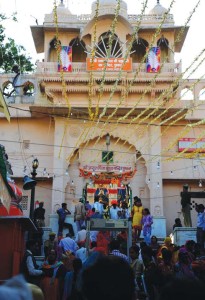
A new consort (a shepherd’s daughter) was identified and sanctified (by passing her through a cow’s body and given the name Gayatri in her second birth) and the yajna was completed with Gayatri sitting beside Brahma, holding the pot of amrita (elixir of life) on her head and giving ahuti (offering to the sacrificial fire). This didn’t go down well with Savitri, who then cursed Brahma that he would never be worshipped anywhere in the world except in Pushkar. Thus, Pushkar has the only temple in the world dedicated to Brahma! Savitri herself, so the legend goes, merged into the Ratnagiri Hill and emerged as a spring known as the Savitri jharna (stream); a temple in her honour exists here.
Since Brahma performed the yajna at the Pushkar lake from Kartik Shukla Ekadashi to Kartik Poornima, a dip in the waters of the lake on this occasion is believed to be equivalent to performing yajnas for several hundred years. A woman taking a dip in the lake, it is believed, absolves herself as well as her husband of all sins! Many also believe that no pilgrimage to char dham {the four principal pilgrim centres namely, Badrinath (Uttarakhand), Jagannath (Orissa), Rameshwaram (Tamil Nadu) and Dwaraka (Gujarat)} is complete without a dip in the holy waters of this lake. So, millions of pilgrims flock to Pushkar to observe the ritual and bathe on the occasion of Kartik Poornima, or on any of the four days preceding it. Then the pilgrims visit the Brahma temple.
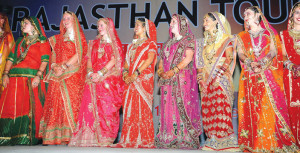
Historical legacy
Hindu mythology attributes the creation of Pushkar to Brahma, but the antiquity of the town and its environs goes back several millennia. Ancient historical literature onwards there are references to Pushkar’s divinity. The great Hindu epics Mahabharata and Ramayana make references to this religious place as the adi tirtha (King of pilgrimages). The Indian scriptures, the vedas and puranas, record that Rishi Vyas undertook penance at Pushkar and Shri Balram, brother of Lord Krishna visited Pushkar more than 5000 years ago. The Harivansha Purana says that Lord Krishna himself spent some time here. The epic Ramayana mentions that the sage Vishwamitra performed penance (tapa) at Pushkar and the celestial enchantress Menaka came to bathe in its serene waters. Historically, the earliest reference to this town is found in the scriptures of the Chinese traveller Fa-Hien. A more concrete reference to Pushkar occurs in the 2nd century BC Sanchi Stupa in Madhya Pradesh which has a stone inscription that mentions the charitable donations made by Buddhist monks or bhikshuks of Pushkar. The earliest punch marked coins, anterior to the 4th century BC, have been found in Pushkar’s environs along with Greek and Gupta coins. A unique and ancient Shivalinga, as tall as a human being, with an image of Krishna, Balarama, Devi and Surya is found in the vicinity of Pushkar. It is thought to date from 200 AD.
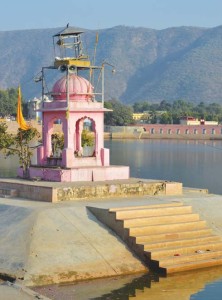
The great Indian poet, Kalidas also immortalised Pushkar in his classic, Abhijñâna Sâkuntalam. In 1073 AD, a Chauhan king Singhraj, visited Pushkar, bathed at the ghats and in gratitude donated four villages for the maintenance of the temples. Prithviraja I is said to have defended the people of Pushkar from the invading Chalukyas in 1105 AD. The Rajput kings of Bundi, Bikaner, Jaisalmer and Scindia made valuable contributions in making and developing the ghats and structures around the sacred lake. Raja Man Singh I of Ajmer built a royal guest house, namely Man Mahal – the largest one in Pushkar in the east of the sacred lake. It affords a clear view of the banks and temples located around the lake. It has since been converted into a heritage hotel.
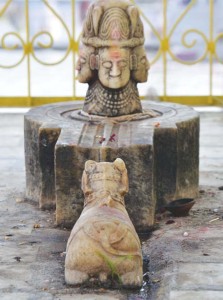
Historical works like Prithviraj Vijay by C. Jayanak (a contemporary account of the 12th century kingdom of Ajmer ruled by the Chauhan clan), Hamir Mahakavya and Surjan Charitra, suggest that an ancestor of the Chauhan dynasty Rishiraj Shri Chahman, was born in Pushkar. The Chauhan queen Rudrani, also known as Atma Prabha used to light 1000 lamps daily before the Shivalinga at Pushkar. Vakpati Raj, a Pilgrims gather in large number to witness maha aarti at Varaha ghat descendant of the Chauhan clan, built the temple of Shiva, here in the 10th century AD.
In more recent times, one of the first contacts between the Mughal and the British took place in Pushkar when Sir Thomas Roe met Emperor Jahangir in 1616 AD. The Mughals, the Rajput kings of Amber, Bundi, Bikaner Jaisalmer, and the Scindias ruled this sacred place till the British placed all the princely states under their direct control in Pushkar in 1818 AD. It was one of the few places in Rajasthan which was directly under the control of the British Government. The British combined religion with trade and introduced the cattle fair in Pushkar. Col. James Tod has made many references to Pushkar in his classical masterpiece Annals and Antiquities of Rajasthan.

The one-of-a-kind Brahma Temple
Pushkar’s star attraction is its unique Shri Brahma Temple. On Kartik Poornima, a festival dedicated to Brahma is held when large numbers of pilgrims take a bath in the sacred lake and visit this temple.
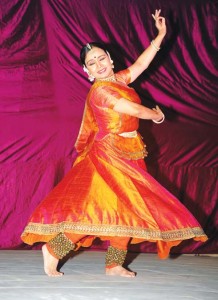
The present temple structure dates to the 14th century, but the shrine is believed to be 2000 years old. It is mainly built of marble and stone slabs. A beautifully carved silver turtle sits on the floor facing the garbha griha or sanctum sanctorum. The marble floor around the silver turtle is embedded with hundreds of silver coins with donors’ names engraved on them. Similar coins are also inset in the walls of the temple. Peacocks adorn the temple walls, as they are believed to be the vehicle of Saraswati. It has a distinct red pinnacle (shikhara) and a hansa (swan) bird motif. The sanctuary has silver doors inside a carved marble gateway. A small image of Gayatri flanks the Chaumurthi, the four-faced image of Shri Brahma. The temple is bereft of any exquisite carvings or artwork found in most other temples. This unique temple pulls in thousands of pilgrims and tourists every year.
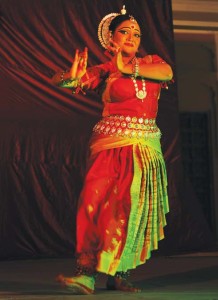
The Pushkar mela
The other attraction of Pushkar, especially during the Kartik month is the Pushkar mela. This mela (fair) held every year in this holy month, brings together the religious, the cultural and the commercial in a perfect symphony. Preparations for the fair begin soon after Diwali The fair begins on ashtami day (8th day of the Kartik month) and lasts till Kartik Poornima (full moon night). It’s as much a celebration of divinity as it is of the town’s vivid culture and its people.

The first 4-5 days are reserved for the camel fair considered the largest such fair in Asia. The star attraction are the 50,000 camels, innumerable sheep, bulls, cows and horses, which majestically amble their way through the golden sands to converge at Pushkar. In the scrublands beyond the west of the Brahma temple, pitched tents and temporary barricades become a temporary home to the thousands of camels. As the early morning mist of the desert gives way to warm sunshine, the herders and traders busy themselves cooking rotis and sipping tea at the golden sands, while the camels bask in the early morning sunlight in the desert.
The Pushkar lake has a whopping 52 ghats or lakefronts! Originally, there were only 12 ghats around the lake. About 1100 years ago, King Rao Nahar Mal Parihara of Mandore got a few permanent ghats constructed after he was cured of a skin disease after taking a bath in the Pushkar lake. Other kings followed suit and today there are 52 ghats which also connect many old and new temples. Of the 52, the Varaha, Brahma and Gau Ghat are considered the most sacred.Lord Vishnu is believed to have appeared at Varaha Ghat in the form of a wild boar. Brahma took a bath here and performed yajna at the Brahma Ghat accompanied by Vishnu and Mahadev. It is said Adi Guru Shankaracharya and Maha Mandaleshwar took a holy bath at Brahma Ghat. In recent times, Shri Jayendra Saraswathi has got a Shankaracharya temple constructed here. The Gau Ghat was renovated 400 years ago. There is also a Zenana Ghat which was renovated by Queen Mary of London.
Each ghat’s water is said to be imbued with special curative properties. For instance, the Nag Kund is known to cure fertility, the Roop Tirth Kund is known to enhance beauty, the water of Kapil Vyapi Kund is said to cure leprosy while a dip in the Mrikand Muni Kund is said to grant the boon of wisdom! These beliefs are well-entrenched among the thousands who flock to Pushkar every year. And beliefs tempered by religion are eternal!
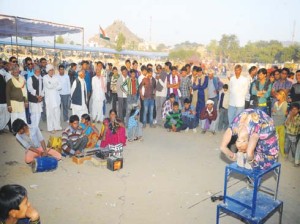
Pushkar is one place where man-animal relationship acquires a new meaning. The camels are lovingly sheared, scrubbed, washed and perfumed. Symbolic hair motifs called moondra are carved onto the fur and tattoos are stamped on the sheared skins using back henna and heated ladles. Then they are bedecked in their best finery, silver bells and silver jewellery for the beauty contest! The camel race is another much awaited event at the fair. The camels are judged on the basis of their gait, humps and ability to obey their master’s commands. An interesting event called Laddoo Oont is held where camels compete to be pronounced the strongest based on the maximum weight they can carry. And can you guess what is loaded on the camels to test their strength? People! One after another people clamber on to the back of the camel till the point when the camel dislodges its burden. In utter merriment everyone comes crashing down!

In another event, reminiscent of musical chairs, the camel sticks its long neck between two poles under the guidance of its owner, who prods the animal by means of a silken cord attached to the camel’s nose ring. Visitors also enjoy the camel dance competition. This fair is not just about fun and games, though that is an important aspect of the fair. This is also a trader’s fair where camels are bought and sold. New owners walk away proudly with their animals in tow. They are not averse to showing off their acquisition to the tourists gathered there! A day before Kartik Poornima the traded animals are let off the grounds.
Culture, colour and contests
After this spectacular show of camels, the town of Pushkar puts its best cultural foot forward. As the sun sinks and the evening turns mellow, the ringing of bells and the soft sounds of hymns and prayers in the temples fill the air. Pilgrims and tourists gather in large numbers to witness the maha aarti held at Varaha Ghat in the evening. Thousands of tiny leaf boats (pattals) – each carrying flowers and an oil lamp – are set afloat on the crystal clear waters of the lake, giving it a mystical tint. A thousand stars flicker and twinkle together in the divine lake, which is illuminated in magical hues of golden yellow, orange and red!
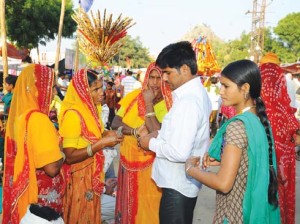
At a stone’s throw away from Varaha Ghat, exhibitions are organized at the Old Rangji Temple. This year, the travel company, Indian Terrains plans to focus on art works relating to ‘India’s vanishing works’. The same venue also traditionally hosts mesmerising dance performances by noted artists in the evening. In the past, eminent artists like Malati Shyam (Kathak, Lucknow Gharana) and Kavita Dwibedi (Odissi) have performed here. A spiritual walk Pushkar Parikrama is organised from the Brahma Temple.
Brightly turbaned men with impressive moustaches and women in vibrantly coloured lehengas (ethnic skirts) and odhnis (long colourful stoles worn by women over lehengas) lend a majestic air to the fair. It is common to see village women in intricately embroidered, swirling skirts, spontaneously pull the ghunghat (veil) over their faces at the sight of a stranger! Local artistes amuse visitors with music and cultural dances of Rajasthan. Local women make beautiful, intricate henna patterns on the hands and feet of visitors, adding yet another colourful dimension to the fair.
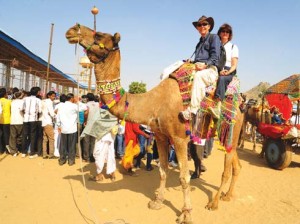
The fair has many games and events for tourists, both domestic and foreign. For instance, the matka (water pot)
race between domestic and foreign tourists, moustache competition, wrestling competition, turban tying competition, puppet shows, acrobat shows, magic shows, tight rope balancing and cartwheels through flaming rings by young girls, snake and mongoose fights, and snake charmers, who sway the crowds with their antics. A very popular contest, especially among foreigners is the Indian bride and bridegroom competition, where the tourists dress up in bridal clothes! This event is held at night in the mela ground and is a major draw among the tourists. Prizes are given away to the best dressed couples.

The mela ground becomes a beehive of activities during the fair. The giant wheels, merry-go-round, and magic shows are a big draw among children. Artistes of various age groups who perform in poor rural areas assemble here and present shows one after another. One can also see many nautankis or street shows through the day. There are also camel safaris on offer and many tourists enjoy this experience of riding the colourfully canopied camels. The mela ground turns into a sea of humanity on the last day of the fair. Visitors start arriving since early hours of the morning to occupy the gallery for the daylong valedictory celebrations. Cultural programmes by folk artistes, camel parade, camel race, horse race, tug of war, water pot race and jalebi race are part of the closing ceremony of the mela.

Besides pilgrims, visitors, traders, domestic and foreign tourists, thousands of sadhus also throng the sands of Pushkar. Dressed in saffron clothes with garlands of flowers about their necks, the ash-smeared sadhus are held in great respect by the pilgrims. The devotees offer food, sweets, clothes and cash to the sadhus and seek their blessings.
Shopping mecca
The Pushkar mela is also known for the multitude of shopping options, especially of ethnic handicrafts. The markets are full of stalls selling lovely colourful bangles, beads, necklaces, embroidered shawls, clothes embedded with mirrors, textiles, ethnic jewellery, costume jewellery, miniature paintings, beautiful wall hangings, blue pottery, puppets, brass utensils, leather goods, shoulder bags, and ropes; the list is endless! It is not just tourists, but locals too who find this the perfect place to pick up various items, especially textiles like odhnis, ghagras, leharia fabrics, intricate silver ornaments, hairpins and so on. Numerous stalls of trinkets, silver ornaments, chains, nose rings, necklaces, waistbands, anklets, toe rings, hairpins, chains and the ivory bangles worn from wrist to shoulder lure the rural women and foreign tourists. Garments and tattoos are also very popular among womenfolk. Rustic women dressed in their finery sell glittering wares.

An Art and Craft Bazar (Shilpgram), Rural Grama Haat (exhibition ground) and the Pushkar Udyog Craft Mela are also organised to help the Rajasthani craftsmen to sell their produce to the tourists.
Pushkar in a nutshell
The annual fair at Pushkar is a combination of the religious, the social and the cultural. Visitors can just laze around the ghats in the pre-dawn hours and be mesmerized by how life unfurls here in all its beauty and serenity. A late evening visit to the ghats, to the accompaniment of soft music playing in the various hotels and guesthouses along the lakefront, can be a most invigorating experience. One can also spend hours feeding the flocks of pigeons on the ghats!

A popular thing to do is to go up to the Savitri Devi temple on the Ratnagiri Hill and enjoy the beautiful sunset views; or just pay a visit to the Gayatri temple atop another small hill for a beautiful sunrise! One can also explore the sand dunes on a Foreign tourists participate in the ‘Indian bride’ competition camel, learn some local music and get an Ayurvedic massage. Pushkar’s food is a big part of its appeal. One can satisfy one’s taste buds with the sweet, mouthwatering malpua in the Halwai gali, or try the famous Rajasthani delicacies like dal baati churma or indulge in some shakes and juices at a café! No visit to Pushkar can be rounded off without indulging in at least a few souvenirs! The religiously inclined can visit the temples and take part in the chanting of hymns and bhajans. Though Pushkar can be visited at any time of the year, the month of Kartik lends a special fervour to the town and should figure on every tourist’s bucket list!


